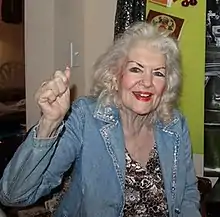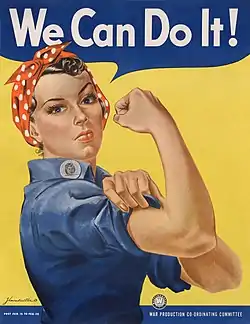Naomi Parker Fraley
Naomi Parker Fraley (August 26, 1921 – January 20, 2018) was an American war worker who is now considered the most likely model for the iconic "We Can Do It!" poster.[2] During World War II, she worked on aircraft assembly at the Naval Air Station Alameda. She was photographed operating a machine tool and this widely used photograph was thought to be an inspiration for the poster. Geraldine Hoff Doyle was initially credited as the subject but research by a professor at Seton Hall University set the record straight.
Naomi Parker Fraley | |
|---|---|
 Naomi Parker Fraley in 2017 | |
| Born | Naomi Fern Parker[1] August 26, 1921 Tulsa, Oklahoma, U.S. |
| Died | January 20, 2018 (aged 96) Longview, Washington, U.S. |
| Occupation | War worker & waitress |
| Known for | "Rosie the Riveter" in We Can Do It! |
| Spouse(s) | Joseph Blankenship (div.) John Muhlig (d. 1971) Charles Fraley (m. 1979; d. 1998)[1] |
After the war, she worked as a waitress in Palm Springs and married three times. When she died, aged 96 in 2018, she was survived by her son and six step-children.[3]
Early life

Naomi Fern Parker was born in Tulsa, Oklahoma, in 1921, as the third of eight children to Joseph Parker and Esther Leis.[1][4] Her father was a mining engineer while her mother was a homemaker. The family moved across the country from New York to California,[5] living in Alameda at the time of the attack on Pearl Harbor.[5] She and her younger sister Ada went to work at the Naval Air station, where they were assigned to the machine shop for aircraft assembling duties.[1]
We Can Do It!

In 1942, Parker's photo was taken at a Pratt & Whitney vertical shaper and it appeared in local press including the Pittsburgh Press on July 5, 1942.[6] The following year J. Howard Miller's "We Can Do It!" poster was one of a series that appeared in factories at Westinghouse in a worker morale campaign.[5] Miller could have seen the picture of Parker, and it is presumed that the newspaper photo was the source of his image.[1]
In 2011, Parker Fraley was at a reunion held at the Rosie the Riveter/World War II Home Front National Historical Park and there she spotted the 1942 photo of her operating a machine.[6] She was surprised to find that the caption said that it was Geraldine Hoff Doyle and she wrote to the park to correct their mistake.[7] They thanked her for telling them the correct name for the photo.[7] Doyle had in innocence thought that the photo was of her and by extension she had decided that the poster was too.[8] This mis-identification then became well-established as sources repeated it – an example of the Woozle effect.[8]
Kimble investigation
Meanwhile, Seton Hall University professor James J. Kimble had become interested in the poster which was now an icon of the feminist movement.[7] He tracked down the original photo and found that it was credited to "Naomi Parker" in 1942.[8] Doyle was still at school and she had only worked at the plant for a few weeks.[4] He found Naomi in 2015 to show her the photo and she still had the cutting from 1942.[5] Kimble was certain that Naomi was the woman in the photo and considered her to be the strongest candidate to be the inspiration for the poster, but noted that Miller did not leave any writings which could identify his model.[1]
In February 2015, Kimble interviewed the Parker sisters, known as Naomi Fern Fraley and Ada Wyn Morford and aged 93 and 91 respectively, and found that they had known for five years about the incorrect identification of the photo, and had been rebuffed in their attempt to correct the historical record.[8]
Later life
After the war, Parker worked as a waitress at The Doll House, a restaurant in Palm Springs, California.[6] She was married three times, first to Joseph Blankenship (divorced), second to John Muhlig, ended with his death in 1971,[1] and third to Charles Fraley (d. 1998), whom she married in 1979.[1][4] In February 2017 she moved to the Longview, Washington, area, before moving into an assisted care home there later that year.[9]
Death
On January 20, 2018, Parker died in Longview, Washington, at the age of 96.[1] The following month, her life was celebrated on BBC Radio 4's obituary programme Last Word.[10]
References
- Fox, Margalit (2018). "Naomi Parker Fraley, the Real Rosie the Riveter, Dies at 96". The New York Times. ISSN 0362-4331. Retrieved January 23, 2018.
- Gunter, Joel (2018). "Mystery real-life Rosie the Riveter dies". BBC News. Retrieved January 23, 2018.
- Kopf, Adam Pasick, Dan. "The riveting story of wartime propaganda that became a feminist icon". Quartz.
- "Naomi Parker Fraley, the real-life Rosie the Riveter, dies at 96". Today. January 29, 2018. Retrieved January 23, 2018.
- "Naomi Parker Fraley, wartime machinist linked to Rosie the Riveter, dies at 96". The Washington Post. January 23, 2018. Retrieved January 23, 2018.
- "Everyone Was Wrong About the Real 'Rosie the Riveter' for Decades. Here's How the Mystery Was Solved". Time. January 23, 2018. Retrieved January 23, 2018.
- "Naomi Parker-Fraley, From Rosie The Riveter Poster, Dies At 96". NPR. January 23, 2018. Retrieved January 23, 2018.
- Kimble, James J. (June 22, 2016). "Rosie's Secret Identity, Or, How to Debunk a Woozle by Walking Backward through the Forest of Visual Rhetoric". Rhetoric & Public Affairs. 19 (2): 245–274. doi:10.14321/rhetpublaffa.19.2.0245. ISSN 1534-5238. S2CID 147767111.
- Luck, Marissa (May 27, 2017). "Who was 'Rosie the Riveter'?". Longview Daily News. Retrieved April 19, 2018.
- Presenter: Julian Worricker; Interviewed Guests: John Fraley, James J Kimble (February 9, 2018). "John Mahoney, Hannah Hauxwell, Professor Kenneth Richard Seddon OBE, Sir John Cotterell, Naomi Parker Fraley". Last Word. 23:05 minutes in. BBC. BBC Radio 4. Retrieved February 11, 2018.